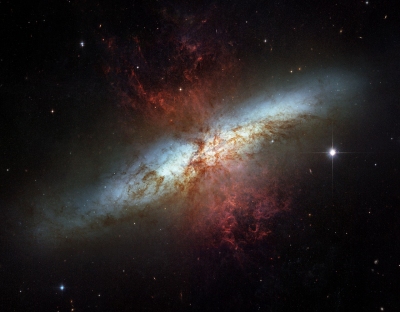16th Anniversary of Hubble Space Telescope [heic0604]
24 April 2006
To celebrate the NASA-ESA Hubble Space Telescope's 16 years of success, the two space agencies are releasing this mosaic image of the magnificent starburst galaxy, Messier 82 (M82). It is the sharpest wide-angle view ever obtained of M82, a galaxy remarkable for its webs of shredded clouds and flame-like plumes of glowing hydrogen blasting out from its central regions.Throughout the central region of Messier 82, young stars are being born 10 times faster than they are inside in our Milky Way Galaxy. These numerous hot new stars emit not only radiation but also particles called a stellar wind. Stellar winds streaming from these hot new stars also have combined to form a fierce galactic superwind. This superwind compresses enough gas to make millions more stars and blasts out towering plumes of hot ionised hydrogen gas, above and below the disk of the galaxy (seen in red in the image).
 |
|
Starburst galaxy M82 |
In M82 young stars are crammed into tiny but massive star clusters which themselves then congregate by the dozen to make the bright patches or starburst clumps seen in the central parts of M82. The individual clusters in the clumps can only be distinguished in the ultra-sharp Hubble images. Most of the pale objects sprinkled around the main body of M82 that look like fuzzy stars are actually star clusters about 20 light-years across and containing up to a million stars.
The rapid rate of star formation in this galaxy will eventually be self-limiting. When star formation becomes too vigorous, it will destroy the material needed to make more stars and the starburst will subside, probably in a few tens of millions of years.
Located 12 million light-years away, M82 appears high in the northern spring sky in the direction of the constellation Ursa Major, the Great Bear. It is also called the Cigar Galaxy because of the elongated elliptical shape produced by the tilt of its starry disk relative to our line of sight.
The observation was made in March 2006 with the Advanced Camera for Surveys' Wide Field Channel. Astronomers assembled this 6-image composite mosaic by combining exposures taken with four coloured filters that capture starlight from visible and infrared wavelengths as well as the light from the glowing hydrogen filaments.
Hubble was launched on 24 April 1990, aboard the space shuttle Discovery.
# # #
Notes for editors
In its 16 years of viewing the sky, the NASA/ESA Hubble Space Telescope has taken roughly 750 000 exposures and probed about 24 000 celestial objects. Hubble does not travel to stars, planets and galaxies. It snaps pictures of them as it whirls around Earth. In its 16-year lifetime, the telescope has made nearly 93 500 trips around our planet, racking up almost 4000 million kilometres. That mileage is slightly more than a round trip to Saturn.
The telescope's observations have produced more than 27 terabytes of data, equal to roughly 400 000 compact discs. If those compact discs were stacked on top of each other, they would be nearly two times taller than the Eiffel Tower in Paris, France.
Each day the orbiting observatory generates about 10 gigabytes of data, enough information to fill up the hard drive of a typical home computer in a week.
In Hubble's 16-year lifetime, about 4000 astronomers from all over the world have used the telescope to probe the universe.
Astronomers have published more than 6300 scientific papers on Hubble results.
The Hubble Space Telescope is a project of international cooperation between ESA and NASA.
Image credit: NASA, ESA and the Hubble Heritage Team (STScI)
Acknowledgment: J. Gallagher (University of Wisconsin), M. Mountain (STScI) and P. Puxley (NSF)
Contacts
Jay Gallagher
University of Wisconsin, USA
Tel:+1-608-263-2456
E-mail: jsg astro.wisc.edu
astro.wisc.edu
Lars Lindberg Christensen
Hubble/ESA, Garching, Germany
Tel: +49-89-3200-6306
Cellular: +49-173-3872-621
E-mail: lars eso.org
eso.org
Ray Villard
Space Telescope Science Institute, Baltimore, USA
Tel: +1-410-338-4514
E-mail: villard stsci.edu
stsci.edu
Keith Noll
Space Telescope Science Institute, Baltimore, USA
Tel: +1-410-338-1828
E-mail: noll stsci.edu
stsci.edu

